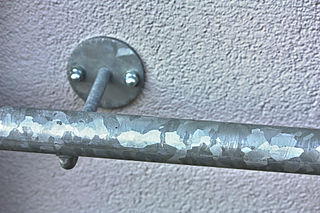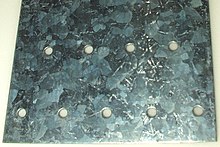
Galvanization or galvanizing is the process of applying a protective zinc coating to steel or iron, to prevent rusting. The most common method is hot-dip galvanizing, in which the parts are coated by submerging them in a bath of hot, molten zinc.

Rust is an iron oxide, a usually reddish-brown oxide formed by the reaction of iron and oxygen in the catalytic presence of water or air moisture. Rust consists of hydrous iron(III) oxides (Fe2O3·nH2O) and iron(III) oxide-hydroxide (FeO(OH), Fe(OH)3), and is typically associated with the corrosion of refined iron.

Hot-dip galvanization is a form of galvanization. It is the process of coating iron and steel with zinc, which alloys with the surface of the base metal when immersing the metal in a bath of molten zinc at a temperature of around 450 °C (842 °F). When exposed to the atmosphere, the pure zinc (Zn) reacts with oxygen (O2) to form zinc oxide (ZnO), which further reacts with carbon dioxide (CO2) to form zinc carbonate (ZnCO3), a usually dull grey, fairly strong material that protects the steel underneath from further corrosion in many circumstances. Galvanized steel is widely used in applications where corrosion resistance is needed without the cost of stainless steel, and is considered superior in terms of cost and life-cycle. It can be identified by the crystallization patterning on the surface (often called a "spangle").

Cathodic protection is a technique used to control the corrosion of a metal surface by making it the cathode of an electrochemical cell. A simple method of protection connects the metal to be protected to a more easily corroded "sacrificial metal" to act as the anode. The sacrificial metal then corrodes instead of the protected metal. For structures such as long pipelines, where passive galvanic cathodic protection is not adequate, an external DC electrical power source is used to provide sufficient current.
Metal fume fever, also known as brass founders' ague, brass shakes, zinc shakes, galvie flu, galvo poisoning, metal dust fever, welding shivers, or Monday morning fever, is an illness primarily caused by exposure to chemicals such as zinc oxide (ZnO), aluminium oxide (Al2O3), or magnesium oxide (MgO) which are produced as byproducts in the fumes that result when certain metals are heated. Other common sources are fuming silver, gold, platinum, and chromium.

Steel frame is a building technique with a "skeleton frame" of vertical steel columns and horizontal I-beams, constructed in a rectangular grid to support the floors, roof and walls of a building which are all attached to the frame. The development of this technique made the construction of the skyscraper possible.
Tinplate consists of sheets of steel coated with a thin layer of tin to impede rusting. Before the advent of cheap milled steel, the backing metal was wrought iron. While once more widely used, the primary use of tinplate now is the manufacture of tin cans.

Tinning is the process of thinly coating sheets of wrought iron or steel with tin, and the resulting product is known as tinplate. The term is also widely used for the different process of coating a metal with solder before soldering.

In metalworking, rolling is a metal forming process in which metal stock is passed through one or more pairs of rolls to reduce the thickness, to make the thickness uniform, and/or to impart a desired mechanical property. The concept is similar to the rolling of dough. Rolling is classified according to the temperature of the metal rolled. If the temperature of the metal is above its recrystallization temperature, then the process is known as hot rolling. If the temperature of the metal is below its recrystallization temperature, the process is known as cold rolling. In terms of usage, hot rolling processes more tonnage than any other manufacturing process, and cold rolling processes the most tonnage out of all cold working processes. Roll stands holding pairs of rolls are grouped together into rolling mills that can quickly process metal, typically steel, into products such as structural steel, bar stock, and rails. Most steel mills have rolling mill divisions that convert the semi-finished casting products into finished products.

Companhia Siderúrgica Nacional (CSN) lit. 'National Siderurgy Company' or 'National Steel Company' is the largest fully integrated steel producer in Brazil and one of the largest in Latin America in terms of crude steel production. Its main plant is located in the city of Volta Redonda, in the state of Rio de Janeiro. Its current CEO is Benjamin Steinbruch.

Tadeusz Sendzimir was a Polish engineer and inventor of international renown. He held 120 patents in mining and metallurgy, 73 of which were awarded to him in the United States.
PPGI is pre-painted galvanised iron, also known as pre-coated steel, coil coated steel, color coated steel etc., typically with a hot dip zinc coated steel substrate.
Sherardising is a process of galvanization of ferrous metal surfaces, also called vapour galvanising and dry galvanizing. The process is named after British metallurgist Sherard Osborn Cowper-Coles who invented and patented the method c. 1900. This process involves heating the steel parts up to c. 500 °C in a closed rotating drum that contains metallic zinc dust and possibly an inert filler, such as sand. At temperatures above 300 °C, zinc evaporates and diffuses into the steel substrate forming diffusion bonded Zn-Fe-phases.
Galvannealed or galvanneal is the result from the processes of galvanizing followed by annealing of sheet steel.

Sheet metal embossing is a stamping process for producing raised or sunken designs or relief in sheet metal. This process can be made by means of matched male and female roller dies, or by passing sheet or a strip of metal between rolls of the desired pattern. It is often combined with foil stamping to create a shiny, 3D effect.
Zinc ammonium chloride is the inorganic compound with the formula (NH4)2ZnCl4. It is the ammonium salt of tetrachlorozincate. It used as a flux in the process of hot-dip galvanizing.
This steelmaking plant was originally part of the Ford Motor Company, which created an integrated manufacturing complex to produce all major vehicle components at one large facility called The Rouge. In 1989, Ford's steel mill assets were divested and became known as Rouge Industries with the steel operations trading as Rouge Steel Company in Dearborn, Michigan, outside of Detroit.
Bethanization is a process patented by the Bethlehem Steel Company to protect steel from corrosion by plating it with zinc, a process similar to electrogalvanization. In advertising materials, Bethlehem Steel claimed the process was more effective than hot dip galvanization, the most common means of using zinc to protect steel.
According to EN 13523-0, a prepainted metal is a ‘metal on which a coating material has been applied by coil coating’. When applied onto the metallic substrate, the coating material forms a film possessing protective, decorative and/or other specific properties.
The Mon Valley Works–Irvin Plant is a steel processing plant operated by U.S. Steel and historically a "hot strip mill" in the Pittsburgh suburb of West Mifflin, Pennsylvania. The site consists of 650 acres on a hilltop 250 feet above the Monongahela Valley. The plant has an annual capacity of 2.9 million net tons of steel from an 80″ hot strip mill, 64″ and 84″ Pickle lines, 84″ five-stand cold reduction mill, continuous annealing line, batch and open-coil annealing facilities, 84″ temper mill, 52″ hot-dip galvanizing line and a 48″ hot-dip galvanizing line, as well as the #11 Shear Line and #17 Recoil line.









